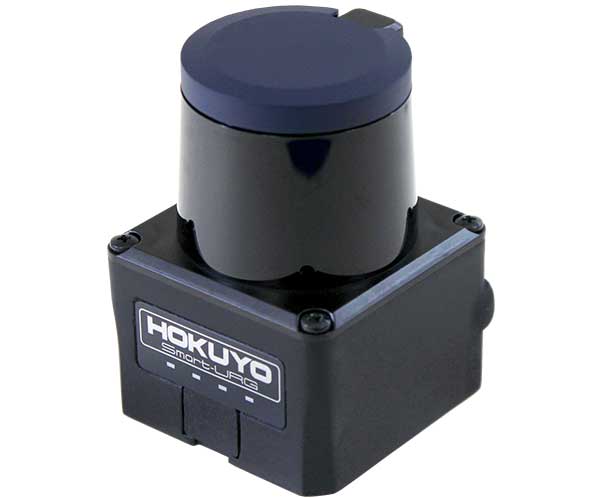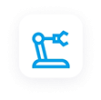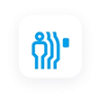Unimate, a hydraulically actuated programmable manipulator arm, was the first commercially used robot. Its entry in 1961 was an announcement of the robot-led industrial revolution.
Today, 64 years later, there are 197 robots per 10,000 employees in North America. On a global level, there are 4 million robots active in factories of all kinds and sizes. These numbers demonstrate how closely humans are working with robots in different industries. But as collaboration grows, so do safety concerns.
A study was conducted based on OSHA’s Severe Injury Reports, which concluded that 77 robot-related accidents occurred in the U.S. alone between 2015 and 2022. Such incidents remind us that the progressive use of robots must be made safer.
Advanced LiDAR laser sensors have become the ultimate solution for ensuring safety in human-robot collaboration. The sensors help robots “see” their surroundings, detect human presence, and automatically respond instantly.
Why There’s a Need for Safe Human-Robot Workflows?
Safer human-robot workflows are mandatory to save human lives, which is obvious. However, the following reasons make the safety of this collaboration of the utmost importance.
Compliance with Regulations
OSHA has ISO 10218 and ANSI/RIA TR R15.606-2016 industry standards for industrial robots and cobots. If an incident occurs due to non-compliance with these terms, it can push your company into a legal battle. This puts you, your brand, and your workers all at risk of losing their means to earn at once.
Increase Productivity
To achieve operational efficiency, you can install a LiDAR sensor on the robots so workers don’t have to stop/start them manually. When you try to make the workflow safer, you also give the robots the ability to analyze and act according to their surroundings.
For example, Hokuyo’s UGM-50LAP 2D LiDAR sensors are engineered for obstacle detection in heavy machinery used in agriculture, mining, or port operations. It has a 190° field of view and a range of up to 120 meters, providing sensory capability to robots, helping them see their environment. Therefore, unlike the traditional risky method of manually controlling the robots, which is time-consuming, the autonomous features help decrease downtime.
Boost Employee Morale
Equipping machinery with safety laser scanners gives workers a sense of protection while collaborating with robots. This reciprocates as increased operational efficiency, high-quality production, and streamlined workflow.
Minimize Indirect Costs
As mentioned, OSHA mandates safety regulations, and failing to abide by them results in legal issues. This increases your company's expenditure and hurts its reputation as well. Apart from legal, an unfortunate incident because of robots can also lead to compensation claims.
It will also result in production delays, as the workers will experience demotivation and feel insecure working alongside robots. Thus, your company will have to bear all the losses because safety wasn’t a priority at first.
How Laser Sensors Outperform Traditional Safety Systems
We’ve discussed why; now let’s explore how LiDAR laser sensors can ensure safety in human-robot collaboration.
Reducing “Blind Spots” in Mobile Robotics
Conventional safety systems, like mechanical bumpers, light curtains, or audio/visual alerts such as sirens and warning lights, are reactive, zone-limited, and often static. These systems aren’t incapable of adapting to dynamic environments, detecting obstructions, and sending real-time signals to stop the robots immediately.
The UST-30LX LiDAR sensors overcome these limitations. They have a 270° field of view that can scan an area of up to 30 meters, reducing blind spots. When they detect an obstacle, they can command the AMRs, AGVs, and UAVs to take programmed action.
Limiting Collision Using High-Precision Localization and Mapping (SLAM)

Additionally, the continuous area scanning updates the changes in the layout. This helps them navigate the areas dynamically without needing human interference.
Zone-Based Access Control for Safe Navigation
The LiDAR sensors developed by Hokuyo are programmable to define multiple detection zones. This allows real-time control over robot behavior based on proximity. Once the zones are set, the sensors command the robot to reduce speed or stop the operation.
For example, you can set two zone levels. If a worker enters level 1, the robot will reduce its speed and wait for the worker to move aside and resume its operation. However, if the staff enters level 2, which is very close to the robot, the sensor can command it to stop immediately.
Safe Distance Precision For Close Collaboration
However, if equipped with a UST-30LC LiDAR sensor, it can stop immediately upon detecting an obstacle. This sensor can be used explicitly for area monitoring and can be programmed to reduce speed or stop the robot. Similarly, you can program the sensor for different required actions for close collaborations.
Use Hokuyo’s Advanced Laser Sensors for Safer Human-Robot Collaboration
Robots influence modern industrial, manufacturing, warehousing, and other commercial work sites. They bring precision, speed, and most importantly, automation to the workplace. However, they pose security concerns that LiDAR sensors can aptly solve.
At Hokuyo, we understand the modern industrial needs and support the safe worksite initiatives. That’s why we engineer advanced, precise, compact yet powerful LiDAR laser sensors for various industries. Our mission is to promote industrial automation more safely.
Learn More About Our LiDAR Sensors!

 Factory Automation
Factory Automation Logistics Automation
Logistics Automation Process Automation
Process Automation Crane Collision Avoidance
Crane Collision Avoidance LiDAR/Obstacle Detection
LiDAR/Obstacle Detection Safety Laser Scanners
Safety Laser Scanners Optical Data Transmission
Optical Data Transmission Hot Metal Detectors
Hot Metal Detectors Laser Distance Sensor
Laser Distance Sensor Blog
Blog Whitepapers
Whitepapers Case Studies
Case Studies Infographics
Infographics